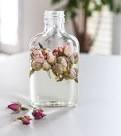Table of Common Latin Names and pH Values - T - Y







Table of Common Latin Names and pH Values - T - Y
| ENGLISH NAME | LATIN NAME | pH |
| Tarragon | Artemesia dracunculus | 3.7-3.8 |
| Thyme geraniol | Thymus vulgaris CTI | 5.0-5.2 |
| Thyme linalol | Thymus vulgaris CT2 | 5.5-5.7 |
| Thyme thuyanol | Thymus vulgaris CT5 | 4.6-4.8 |
| Thyme thymol | Thymus vulgaris CT6 | 4.5-4.6 |
| Tea Tree | Melaleuca alternifolia | 3.9-4.1 |
| White sage | Salvia apiana | 3.6 |
| Wild carrot seed | Dacus carota | 3.8-4.0 |
| Wild ginger | Asrum canadense | 5.4 |
| Winter savory | Satureja montana | 4.1-4.2 |
| Witch hazel | Hamamelis virginiana | 4.0-4.2 |
| Yarrow | Achillea millefolium | 3.6-3.9 |
The information provided in this section refers only to hydrosols. Never substitute essential oils for hydrosols They are much stronger, are not water soluble, and should not be used in the same manner as hydrosols.
Reference: Hydrosols: Suzanne Catty
Nelly GrosJean









Nelly Grosjean
Nelly Grosjean was my first teacher on the possibilities of using aromatic waters therapeutically. her Book Aromatherapy: Essential Oils For Your Health discusses their use and methods of application as well as treatment protocols for specific health concerns.
In her work Grosjean combines oils , hydrosols, diet, and lifestyle as well as massage. Unfortunately the English edition of the book eliminated most of the discussion of internal use; as drinking hydrosols is one of the best ways to use them therapeutically, it is a great shame that the original text is not more widely available.
Under |Nelly's tutelage I undertook a period of experimentation during which I consumed most of my stock in three-week consequences, two tablespoons of hydrosol dissolved in one liter of distilled water daily for twenty-one-days, with a week off in between. I drank liters of hydrosol, I took copious notes, and experienced a gamut of effects.
A course with Nelly followed, during which her autodidactic approach became clearer. She works with a series of twelve essential-oil synergies, one for each month of the year, one for each of the body systems, one for each sign of the zodiac. She calls the blends frictions, and in most cases they are used both internally and topically for a three-week treatment period.
Each friction works with one of several possible hydrosols that provide supporting therapy, and as part of the protocol these hydrosols are to be consumed daily diluted in water ( thirty millilitres of hydrosol per 1.5 liter of water). Depending on the health concern being treated, Grosjean includes suggestions for Raw-diets and juicing. Anyone who has heard her speak or has read her books will know her list of Ten Golden Rules by heart.
The approach made sense to me, and what coalesced in my mind is that for all we talk of using whole, authentic, unadulterated, organic, complete essential oils, if we are not using the distillation water as well, there is a portion of the plant therapeutics that is missing. it has also become abundantly clear to me, as a life long adherent of homeopathic remedies, that the hydrosols are more akin to homeo pathics, on a number of levels, than to the essential oils.
Nelly credits a dream with providing the recipes for her frictions and the combinations in which they are used, and she speaks frequently about the vibrational aspects of aromatherapy. It is gratifying to hear someone discuss the energetic aspect of the waters as part of his or her rationale.
There are those who have discounted her work because of this seemingly unscientific approach, but we are in a new millennium, so perhaps we've learned better.
Reference: Hydrosols; Suzanne Catty
Influences





Influences
In 1995 I received a pamphlet from the Aromatic Plant Project titled 101 ways to Use Hydrosols.
Most of the brochure concerned itself with spraying the waters on your face and body or drinking them because they taste good, but my curiosity was piqued by a world I felt was waiting to be discovered .
Up to that point I had experienced only a few of the so-called floral waters: lavender, rose, orange blossom, rosemary, cornflower, and Roman chamomile. But I had learned enough about distillation to know that, theoretically, every plant that produces an essential oil will, when distilled, produce a hydrosol, and I began to wonder where all this water went and why it wasn't available.
I also instinctively felt that just spraying hydrosols on your face was ignoring the real possibility that these waters were as therapeutic as the oils, or at least as healing as herbs, tisanes, and other plant-based remedies. I began a search for hydrosols from every source I could find.
One organic Italian Neroli was particularly surprising, with an intensity of flavour and scent much closer to that of the oil than anything I had encountered previously. In retrospect I realized that the "hydrosols" I had been buying up to that point probably contained preservatives and/or alcohol, were far from fresh, and could easily have been synthetic. After trying the real Neroli water, I was gone... totally, utterly in love.
Then came the discovery of a company that offered no fewer than twenty different true aromatic waters. This was a revelation! An Aladdin's cave of hydrosols! I now had waters for oils that I barely knew: winter savory, Satureja montana. chemotype-specific hydrosols of rosemary and four different thymes; the expensive and elusive rock rose, Cistus ladaniferus.
But what to do with them all? I had already begun my studies of French aromatherapy, in which essential oils are seen as plant medicines and are used internally, topically, and aerially, not just for massage, as I had learned in England and Canada. So it was to the French that I turned to learn more about the hydrosols in my fridge.
Reference; Hydrosols: Suzanne catty
Chemicals: Friends or Foes?





Chemicals: Friends or Foes
In these articles you will find talk of chemicals and chemistry. After what has been said , this may seem incongruous, but there is no contradiction here. Knowledge of the chemical composition of aromatherapy products is actually of vial importance, since this is a major factor in how they work on our health. It is also one of the keys to empowerment in consumer decision making. Every plant contains a wide variety of chemical compounds. Some of these chemicals exist in the form of aromatic essential-oil molecules, some are alkaloids, others are water-soluble or complex polysaccharides, and there are many more besides.
We know that therapeutic chemicals from plant material can be extracted by soaking the material in cold water (cold infusion), heating the material in water (decoction or tea), infusing the material in oil (maceration), extracting components in alcohol (tinctures), or distillation (essential oils and hydrosols). It is important to remember that there are many ways to extract the therapeutic benefits from plant material because each method will release different qualities and chemicals of the plant and therefore have different properties and applications in health and healing.
The primary issue here is not only that these are naturally occurring chemicals manufactured by the plants as part of their desire to grow, flourish, and propagate themselves, but also that they appear in complex combinations, not as singly or isolated compounds. Rose contain over 400 different chemicals, clary sage around 250, and lavender more than 100. Herein lies the rub! Mother nature is incredibly intelligent, and plants have spent millions of years evolving and using their chemicals to communicate with each other and with the world at large. Some of their chemicals protect them from predators, others alert them to weather changes and soil conditions, still others send messages about potential pollution and seed carriers.
These chemicals exist in combination because that's how they work best, together in synergy, like an orchestra. A sols violin is nice, but Beethoven sounds better with a full complement of instruments. When we talk about chemical sensitivities or even, specifically, about fragrance sensitivities, we often forget to note whether these chemicals and fragrances are natural or synthetics, isolated or in combination. And that makes all the difference!
The smell of chamomile is added to many shampoos that contain chamomile "extracts". The smell ahs to be added because the extracts are usually isolated chemicals chosen for a specific action, and this may have no odor or a non-chamomile odor. The smell component may or may not be natural; if it is natural, it may again be an isolated chemical chosen for scent only.
What we have is not what nature created, While 100 percent natural chamomile may not cause an allergic reaction in people, some of its chemicals taken in isolation -out of context, if you will-can cause an allergic response. And synthetic versions of chamomile will almost certainly cause a reaction in sensitive people.
The prescription drug Valium illustrates this point most clearly. There is a herb called valerian that has been used for thousands of years for its relaxing, antianxiety, and sedative properties, and Valerian products can be found in most health food stores. Recognizing its therapeutic value, scientists studied valerian in order to isolate the one chemical they felt was responsible for its desirable effects. They then worked on this chemical in the lab and finally came up with a drug they call Valium. it was a huge success. and millions of people, mostly women, were prescribed valium for many years.
We now know that this drug, for all its benefits, has some pretty serious side effects and, for many, it is highly addictive. World wide, there ate still thousands of people suffering its ill effects. In Britain there were so many lawsuits that the government withdrew legal aid for Valium cases in the early 1990s. What went wrong? is it possible that science, in its desire to find absolute answers, ignored the possibility that more than one chemical may contribute to a herb's beneficial affects? is it that some of the natural chemical combinations in a plant can prevent side effects, one chemical acting as a buffer for another? The scientists were doing their best, but even science is imperfect and is growing, changing, and learning all the time.
It is the same with aromas. If you make a synthetic smell, or isolate just one aromatic chemical from a natural source, you may well end up with a smell that harms. The chemical creating the odor may have a negative effect on health, causing headaches, allergies, skin reactions, nausea, and so on. It is not the order per se that harms but the chemical creating the odor when it is taken out of context. People want scent-free zones because isolated and synthetic chemicals are making them sick. It is not nature, but what we have done to nature, that causes harm!.
Reference: Hydrosols: Suzanne Catty
Articles - Most Read
- Home
- What are Hydrosols
- What are Hydrosols-2
- The Monographs
- How to Make a Hydrosol
- Table of Common Latin Names and pH Values - F - O
- Distilled or Extracted Specifically For Therapeutic Use - 3
- Kurt Schnaubelt
- What isn't a Hydrosol?
- Table of Common Latin Names and pH Values - P - S
- Wholly Water!
- Blue Babies
- Supply and Demands
- Mature Skin
- Recipes Alpha F
- Hydrosols In The Marketplace
- Chemicals: Friends or Foes?
- Hemorrhoids
- Nelly GrosJean
- Water as Medicine
- The Educated Consumer
- Genitically Modified Plants
- Influences
- Water Quality
Articles-latest
- Daucus carota/Wild Carrot Seed - pH 3.8-4.0
- Cupressus sempervirens/ Cypress-pH3.5-3.7
- Coriandrum sativum/Coriander Herb-and-Seed
- Comptonia peregrinal/Sweet Fern- pH 3.8
- Citrus clementine (fe) Clementine Petitgrain- pH 4.3-4.4
- Citrus aurantium var. amara (flos) /Neroli Orange Blossom-pH3.8-4.5
- Cistus ladaniferus/Rock Rose-pH 2.9-3.1
- Cinnamomum zeylanicum (ec) Cinnamon Bark-pH3.3
- Chamaemelum nobile/Roman Chamomile - pH 3.0-3,3
- Centaurea cyanus/Cornflower/Bachelor's Button-pH 4.7-5.0
- Cedrus atlantical/Cedarwood/Atlas Cedar-pH 4.1- 4.2
- Hydrosols -The PH - Anomalies
- Hydrosols- Establishing Shelf Life and Stability
- Boswellia carterii/FRANKINCENSE
- Asarum canadense/ Wild Ginger/Canadian Ginger
- Artemesia vulgaris / Artemesia
- ARTEMESIA DRACUNCULUS - TARRAGON
- Angelica archangelica / Angelica Root - Hydrosols
- The Key, or More Correctly, the pH - 2 - Hydrosols
- The Key, or More Correctly, the pH-Hydrosols
- The Hard pHacts - Hydrosols
- Calamus Root/Sweet Flag - ACORUS CALAMUS
- Yarrow - Achillea millefolium - Hydrosols
- Balsam Fir - Abies balsamea - Hydrosols

